KEY TAKEAWAYS
- Katsina State faces critical issues such as desertification, deforestation, climate change impacts, insecurity, and poor infrastructure. KAGGA identifies these challenges and offers integrated strategies to mitigate and build resilience.
- KAGGA is a comprehensive and transformative framework that integrates environmental sustainability with economic growth, aligning with national and international goals such as Nigeria’s Climate Change Act, the UN SDGs, and the African Union’s Agenda 2063.
KAGGA is tailored to the unique environmental, social, and economic realities of Katsina State. - The agenda, built on four strategic pillars: Climate-Smart Agriculture, Renewable Energy, Ecosystem Restoration, and Green Industrialization, serves as a replicable model for other states in Nigeria.
- KAGGA’s success depends on community engagement, adequate funding, and political commitment, with the potential to generate 100,000 green jobs and reduce CO₂ emissions by 1.5 million tons by 2035.
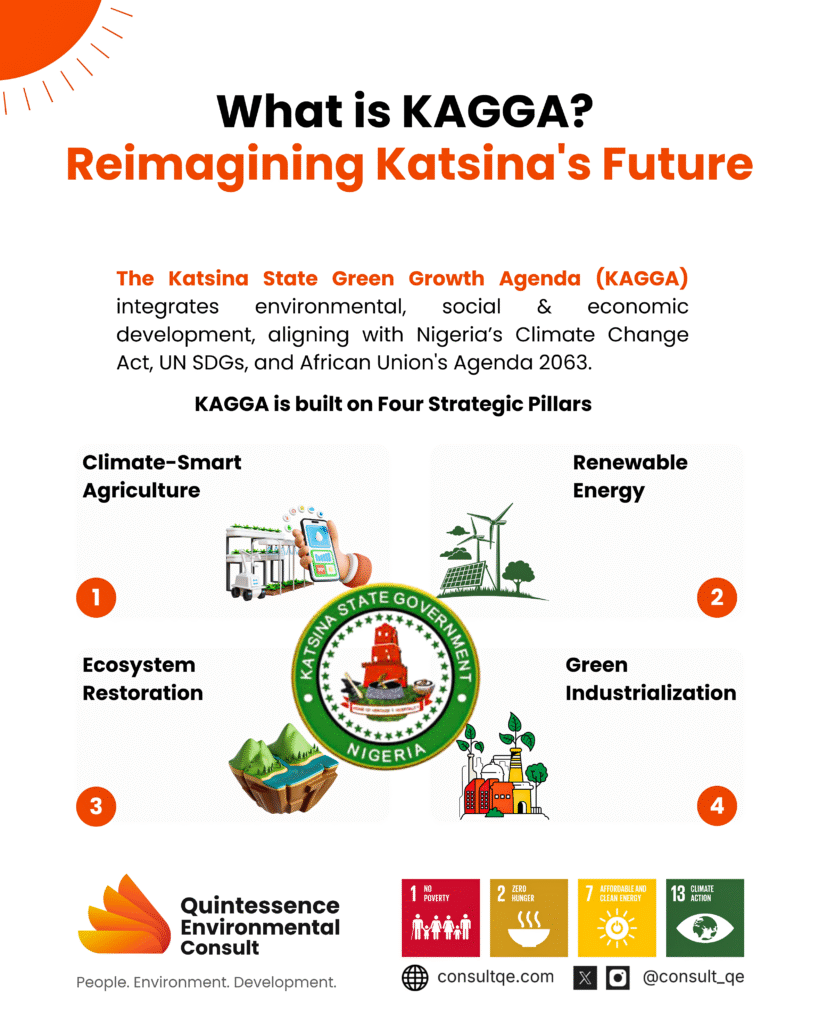
INTRODUCTION
In an era defined by the need for sustainable development, Katsina State has taken a bold and strategic step forward. The Katsina Green Growth Agenda (KAGGA) is more than just a policy document, it is a transformative vision designed to align environmental resilience with economic growth. Developed in response to growing climate vulnerabilities in the state, KAGGA sets out a comprehensive blueprint to unlock the state’s development potential while safeguarding its natural resources for future generations. KAGGA aligns with Nigeria’s Climate Change Act, UN’s Sustainable Development Goals (SDGs) and the African Union’s Agenda 2026 to foster resilience and equity. It is structured around four strategic pillars, which are Climate-Smart Agriculture, Renewable Energy Leadership, Ecosystem Restoration and Green industrialization.
Anchored by a strong commitment from the state government and aligned with broader strategic policies such as the Governor Radda Strategic Policy Framework (BYFSP), the agenda reflects a deep understanding of local realities and global climate imperatives. With sections dedicated to natural assets management, green urban transition, rural livelihoods, and green economic development, the agenda provides a structured pathway toward inclusive and sustainable progress.
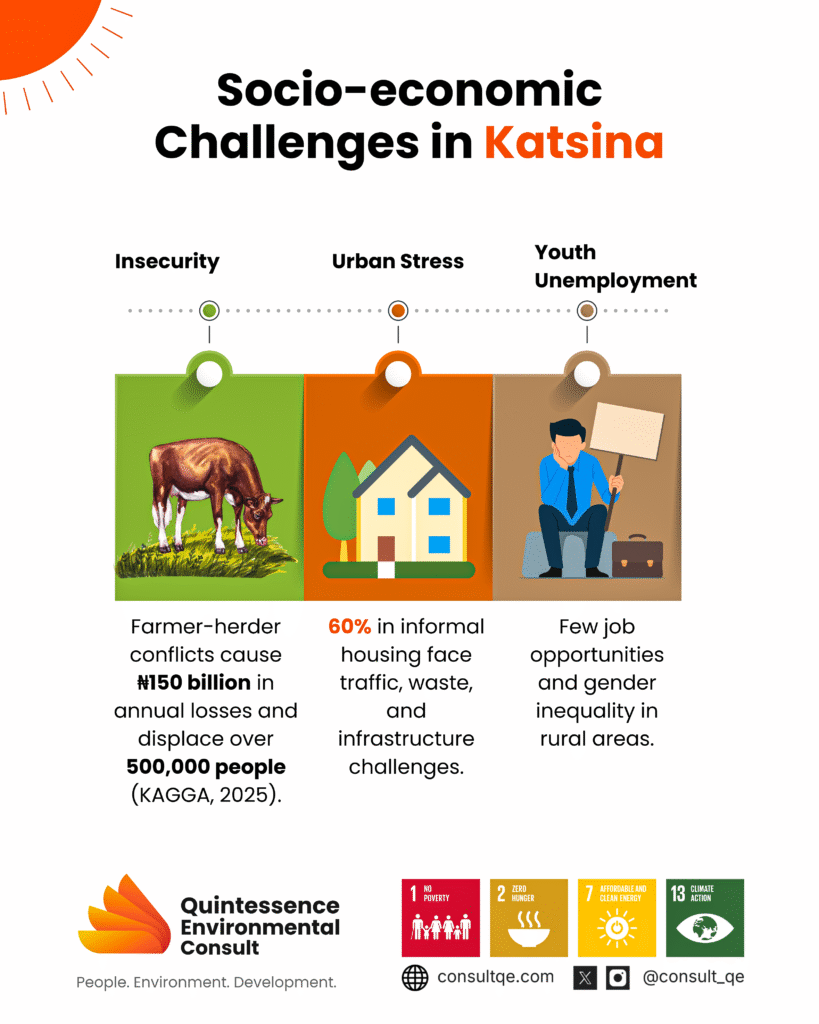
CURRENT CONTEXT AND CHALLENGES
Katsina State faces complex environmental, social, and economic challenges that hinder its sustainable development. Desertification and deforestation, with forest cover shrinking by 15%, are driven by illegal logging, forest fires, and overgrazing, threatening biodiversity and soil stability in local government areas like Jibia and Dutsinma. Climate change, marked by a 20% rainfall decline and frequent droughts affecting 60% of farmlands, worsens food insecurity and rural poverty, as only 5% of farmlands have irrigation, and post-harvest losses reach 40%.
The state is also facing Insecurity, such as cattle theft and farmer-herder conflicts over shrinking grazing lands, which causes N150 billion in annual losses and displaces over 500,000 people. Urban areas are strained by rapid growth and poor infrastructure, facing issues like traffic congestion, open waste burning, and housing deficits, with 60% of residents living in informal settlements.
In Katsina state, 80% of rural communities rely on overexploited groundwater. Meanwhile, illegal mining contaminates 30% of the groundwater in the state, posing health risks and fueling conflicts. High youth unemployment, informal Small and Medium-sized Enterprise operations, and gender disparities further complicate progress, emphasizing the urgent need for integrated strategies to build resilience and sustainability. Despite these challenges, Katsina State holds significant opportunities for sustainable development and green economic growth through KAGGA.
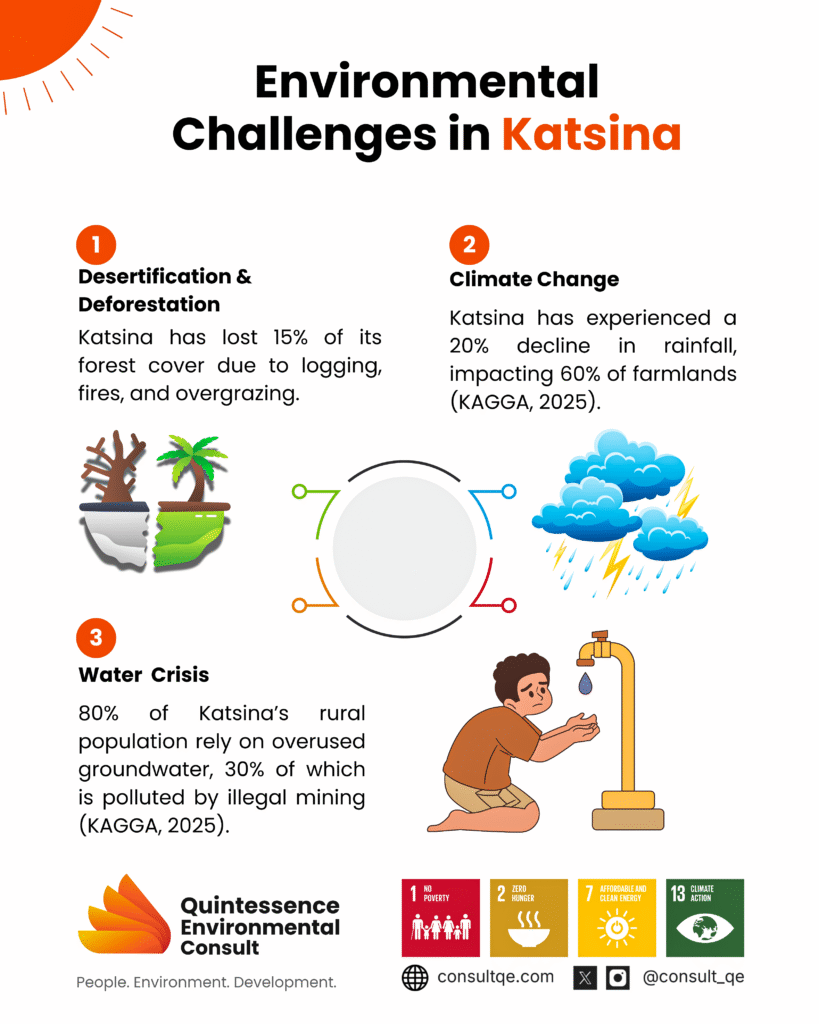
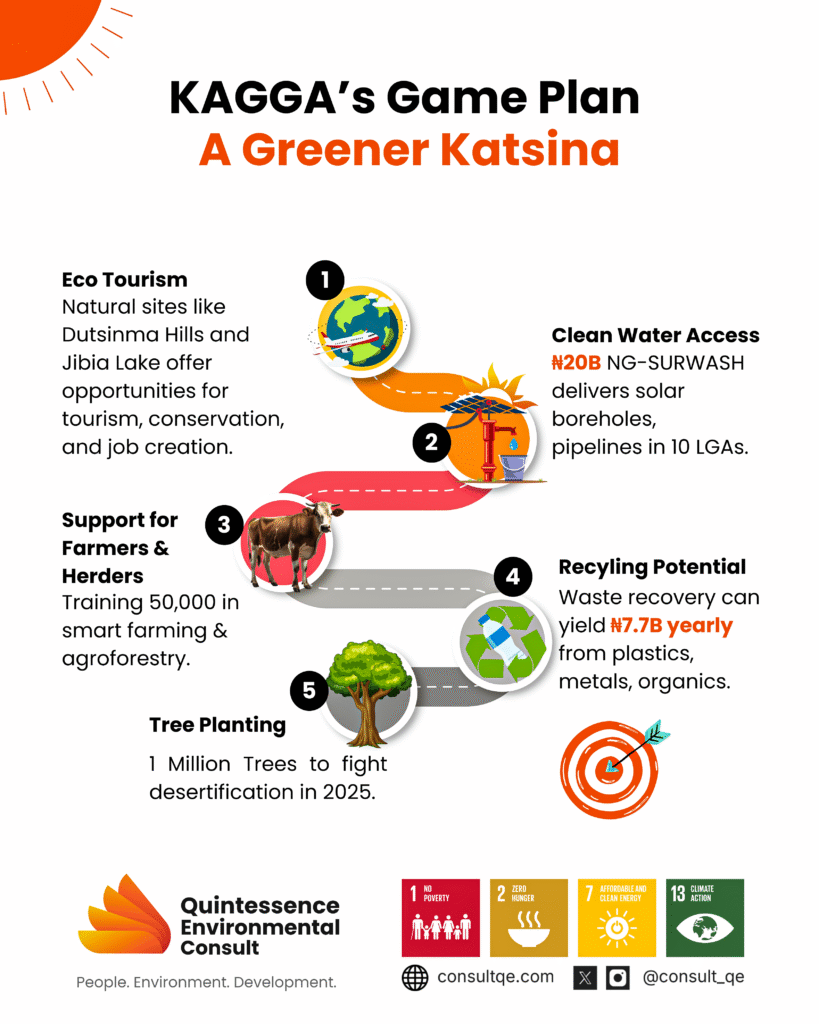
HOPE FOR KATSINA- KATSINA’S GREEN GROWTH AGENDA
At its core, Katsina’s Green Growth Agenda (KAGGA) begins by focusing on the state’s natural assets, addressing critical challenges while leveraging untapped opportunities. Recognizing growing pressures on forests, livestock resources, water systems, and arable land, the agenda outlines actionable strategies to preserve ecosystems and enhance land productivity. Initiatives such as expanding forest reserves and planting 1 million trees in 2025 underscore the state’s commitment to reforestation.
Eco tourism potential is harnessed through landmarks like Dutsinma Hills and Jibia Lake, providing opportunities for conservation and tourism that could drive sustainable economic development. Furthermore, Katsina’s partnership with the World Bank’s NG-SURWASH program injects N20 billion into infrastructure upgrades across 10 LGAs, including solar-powered boreholes and modern pipelines to secure clean water. Community-led conservation initiatives aim to integrate wildlife protection with ecotourism.

- A Multi-Faceted Urban Green Transition
Building upon this ecological foundation, KAGGA transitions to urban areas, addressing the challenges posed by population growth and rapid urbanization. The agenda envisions cities as hubs of innovation, promoting low-carbon infrastructure, affordable housing, urban agriculture, and smart public services. Investments in renewable energy capitalize on the state’s solar potential of 5.8 kWh/m² per day, capable of meeting 70% of urban energy needs while empowering emerging industries like cold storage to reduce post-harvest losses. With a mobile penetration rate of 68%, digital tools and platforms like eKasuwa could connect farmers directly to buyers, streamline traffic, and optimize waste management. Circular economy practices are integrated into urban systems, with the potential to recover N4.2 billion annually from recycling plastics, metals, and organic waste. Municipal waste recycling could further yield N3.5 billion per year, transforming waste into economic opportunity.
- Empowering Rural Communities And Green Industry
KAGGA places significant emphasis on rural communities, which often face the brunt of climate change.
As Governor Dikko Radda said, “Our villages are not relics of the past, but they are laboratories for the future. In these laboratories, waste becomes wages, scarcity becomes abundance, and tradition walks hand in hand with innovation”.
The state is strengthening agricultural resilience by scaling climate-smart crops to cover 50% of farmland by 2030, and training 50,000 farmers in agroforestry, soil conservation, and water-efficient techniques. Untapped livestock value chains, such as dairy, leather, and meat processing, will be supported by the existing agricultural assets, unlocking new economic opportunities. Investments in cultural tourism, such as promoting artisan villages and historic markets, aim to further enhance the rural economic growth in the state
Green industrialization initiatives like waste-to-energy systems and solar-powered cold storage ensure that post-harvest losses are minimized, while renewable energy infrastructure supports small-scale industries. Public awareness campaigns and youth engagement strategies tap into the state’s vibrant population, creating opportunities for employment and education in green jobs. Katsina’s efforts to formalize land rights, streamline taxes, and invest in rural infrastructure ensure that policy reforms align with the broader vision of sustainable development.
DISCUSSION AND RECOMMENDATION
Katsina State Green Growth Agenda (KAGGA) presents an ambitious framework for addressing the state’s environmental, social, and economic challenges as well as promoting sustainable development. By integrating rural and urban resilience, green trade, and poverty and climate vulnerability, KAGGA provides a transformational vision. Its success, however, depends on addressing numerous key gaps, issues, and questions.
A major concern is feasibility in undertaking large scale projects, particularly in rural areas with poor infrastructure. How will the state overcome logistical and operational hurdles in completing such priority projects like reforestation, renewable energy projects, and climate resilient urban planning? Another key concern is stakeholder engagement. Mechanisms must be in place to involve local communities, particularly farmers, herders, and women, in planning and executing these programs. Inadequate inclusive participation can undermine KAGGA’s agenda in matters regarding equity and resilience. Systems for monitoring and evaluation also need to be clearly defined so that transparency and accountability are ensured. Independent audits, measurable performance indicators, and regular reporting mechanisms need to be established to track progress on actions like tree planting, circular economy, and waste recovery. Financial sustainability is also a challenge. Apart from collaborations with organizations such as the World Bank, it is imperative that the state initiate mechanisms to ensure secure funding, simultaneously addressing the up-front expenditures and long-term economic gains. Additionally, industries such as livestock, mining, and waste management must be incentivized to adopt sustainable practices. How will the state encourage compliance and participation in these sectors?
Insecurity remains a significant hindrance to achieving the objectives. Farmer-herder conflicts, livestock theft, and displacement of over 500,000 people annually disrupt agriculture production and sustainability initiatives. Such challenges deter investments in green economy initiatives. Insecurity must be addressed through special interventions such as peace committees, community policing, and early warning systems to foster stability. To enhance KAGGA’s effectiveness, several recommendations are presented. The state should utilize digital technologies such as GIS mapping for prioritization of reforestation, IoT sensors for real-time irrigation and air quality monitoring, and blockchain for transparent land right and resource management. Youth vocational training can build capacities for green jobs, and precision farming can improve crop yields and enhance food security. Modular waste-to-energy plants can address urban waste problems while providing sustainable energy opportunities.
KAGGA’s focus on community driven interventions, such as the integration of controlled artisanal mining cooperatives and the expansion of eco tourism, can further increase its impact. By piloting these approaches and leveraging data driven insights, Katsina can transform its vision into a scalable and replicable model and serve as a beacon of sustainable development for Nigeria and beyond.
.
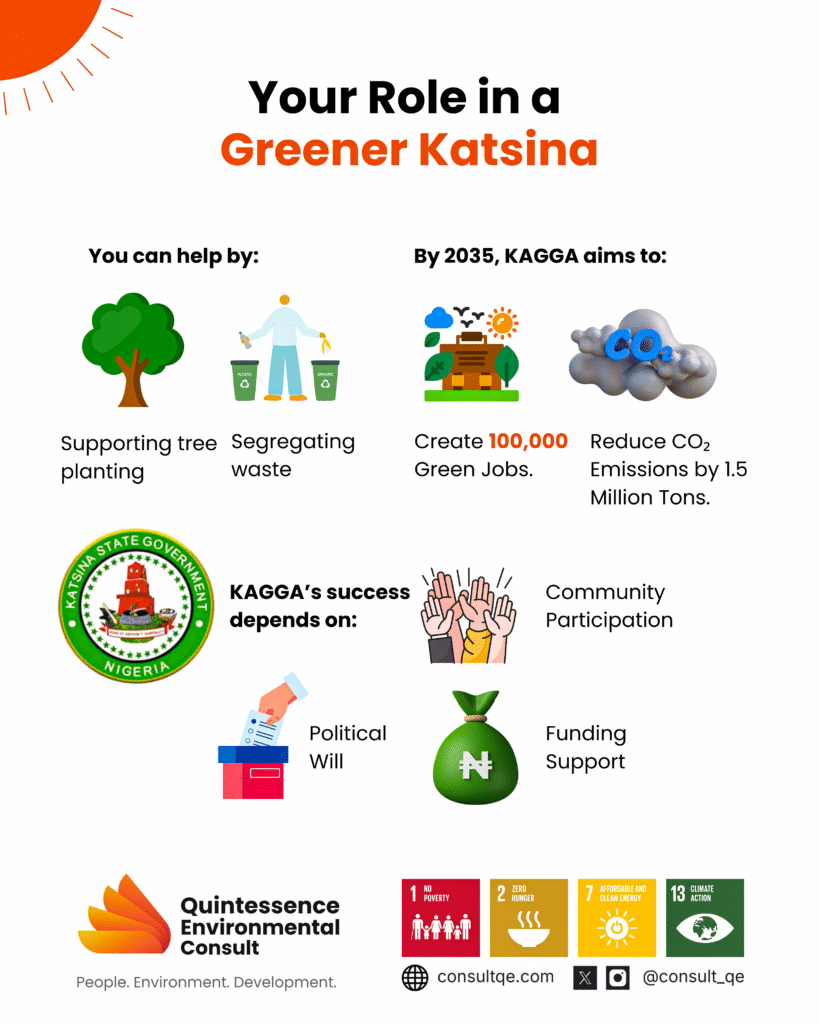
CONCLUSION
Katsina State’s Green Growth Agenda stands as a beacon of what is possible when goals meet political will and community-centred planning. It signals a shift from reactive environmental management to proactive, integrated development, where the environment, people, and economic development are not competing interests but interconnected in priorities. The clarity of vision woven throughout the agenda shows that sustainable growth is not a distant aspiration, but a practical, achievable path grounded in local knowledge and global best practices. As climate risks intensify across Nigeria and beyond, KAGGA offers more than a policy. It offers hope. Hope that a greener, more inclusive, and resilient future can be built from the grassroots. Hope that other states will draw inspiration from this model. And most importantly, hope that by investing in people and the planet together, we can redefine what progress looks like, not just for Katsina, but for all of us.
REFERENCES
Katsina State Government. (2025). Katsina Green Growth Agenda (KAGGA): Blueprint for transforming climate challenges to development potentials. Katsina State, Nigeria.
